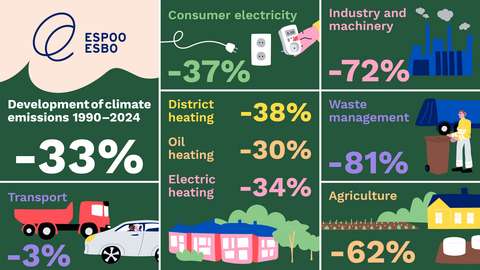Climate emissions decrease despite population growth – Espoo’s emissions continue to decline

Climate emissions generated in Espoo have decreased by 33 per cent since 1990. Emissions per capita have decreased by 64 per cent and are the lowest in the capital region for the eighth consecutive year.
The City of Espoo wants to achieve climate neutrality by 2030. The aim is to reduce climate emissions generated in Espoo by 80 per cent from 1990 to 2030. In recent years, Espoo’s climate emissions have decreased sharply. Emissions generated in the area have decreased by 33 per cent since 1990, now amounting to 709 kt (CO2e). Per-capita emissions have decreased by 64 per cent since 1990.
“We have managed to reduce our climate emissions while our population has almost doubled. Our greatest achievement is that we have reduced emissions from district heating, which used to be our main source of emissions, by 38 per cent. District heating emissions will continue to decrease in the coming years, especially thanks to the utilisation of waste heat from the future data centre. In the future, we will particularly focus on reducing transport emissions in our rapidly growing city,” says Mayor Kai Mykkänen.
Emissions from district heating and consumer electricity have decreased
Together with the energy company Fortum, Espoo is committed to significantly reducing district heating emissions by the end of this decade. The use of coal in district heat production ended in Espoo in April 2024. The transition was carried out by switching to electricity-based solutions, for example using waste heat from data centres and wastewater, electric boilers, heat pumps, and energy from biomass. In Espoo, district heating emissions decreased by 38 per cent between 1990 and 2024 and 15 per cent during the past year.
The decrease in emissions from consumer electricity is largely explained by the reduction of the national emission factor for electricity. Consumer electricity emissions have decreased by 37 per cent since 1990. Other measures to increase the use of renewable and carbon-neutral energy, such as phasing out oil heating and investments in solar panels, also reduce climate emissions.
Transport emissions increased slightly from last year
Transport emissions have decreased in Espoo by 3 per cent since 1990. During the past year, however, transport emissions increased by 4 per cent from the previous year. National road transport emissions have increased slightly, and the emissions in the capital region are consistent with this trend. The main reason for the increase is the reduction in the share of biofuels in comparison with the previous year. Furthermore, the pace of vehicle electrification has slightly slowed down in Espoo compared to previous years. In order to achieve the goal of carbon neutrality, total emissions from transport must also start decreasing. This requires both increasing the share of sustainable modes of transport and transitioning away from fossil fuels in the coming years.
Espoo also aims to reduce consumption-based emissions
The territorial emissions calculation and Espoo’s climate neutrality goal do not take account of the indirect emissions from consumer goods, such as food, goods or construction products. For instance, emissions from construction materials are not included in the emissions generated within Espoo, as the production of these materials takes place outside the city’s boundaries. Espoo aims to reduce both territorial and consumption-based emissions.
Residents’ everyday choices affect all emissions. However, some emissions are easier to influence than others. Every day, we make choices that particularly affect the emissions from food and the goods and services we buy. It is more difficult for an individual to directly influence emissions from construction or district heating, while city-level measures have a significant impact on these emissions. Achieving the city’s climate neutrality goal and reducing emissions will also enable all Espoo residents to reduce their emissions, supporting a sustainable and smoother everyday life.
Read more
- Greenhouse gas emissions in capital region decreased by 11 per cent(external link, opens in a new window) (hsy.fi, in Finnish)
- What makes up the carbon footprint of consumption in Espoo? New insights into Espoo’s consumption-based emissions
- Espoo’s climate goals
- Espoo Climate Watch(external link, opens in a new window): Check out the city’s climate actions and monitor their progress and impact
- Climate budget(external link, opens in a new window): Information about Espoo’s operating expenses and investments promoting climate change mitigation and adaptation